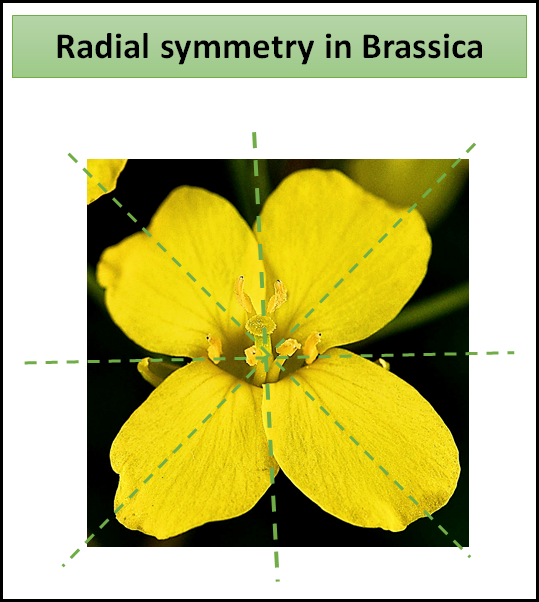
Radial symmetry is seen in flowers of
(a)Cassia
(b)Brassica
(c)Trifolium
(d)Pisum
Answer
503.4k+ views
Hint: When the different parts of each whorl are similar, the flower is regular and is called an actinomorphic flower. This means that all members of a whorl are the same in size and shape.
Complete answer:
Brassica has Actinomorphic flowers i.e it is a flower with radial symmetry. All the petals of brassica are similar in size and shape. The flower can be cut into two equal halves from any plane.
Additional information:

-A flower is supposed to be symmetrical when each whorl comprises an equal number of members or when the members of any one whorl are multiples of that before it.
-Thus, a symmetrical flower may have three sepals, three petals, three stamens, and three carpels, or the quantity of any of these members may be a multiple of three.
-A flower is dimerous in which the parts are in twos; trimerous, tetramerous, or pentamerous, in threes, fours, or fives, respectively.
-When the different parts of each whorl are identical, the flower is regular and is called as an actinomorphic flower or radially symmetrical flower. This is observed in the petunia, buttercup, and wild rose.
-Discrepancies in size or shape of the members of a whorl make the flower irregular such as in the canna and Asiatic dayflower.
-When a flower can be bisected by a single plane into two equal sections, it is a zygomorphic flower or bilaterally symmetrical flower. This is seen in the snapdragon, orchid, and sweet pea.
So, the correct answer is “Brassica”
Note: Trimerous symmetry is the characteristic in the monocotyledons such as maize, rice, coconut, etc. Pentamerous symmetry is the most common symmetry in the dicotyledons, however dimerous and tetramerous flowers are also seen in the dicotyledonous plants.
Complete answer:
Brassica has Actinomorphic flowers i.e it is a flower with radial symmetry. All the petals of brassica are similar in size and shape. The flower can be cut into two equal halves from any plane.
Additional information:

-A flower is supposed to be symmetrical when each whorl comprises an equal number of members or when the members of any one whorl are multiples of that before it.
-Thus, a symmetrical flower may have three sepals, three petals, three stamens, and three carpels, or the quantity of any of these members may be a multiple of three.
-A flower is dimerous in which the parts are in twos; trimerous, tetramerous, or pentamerous, in threes, fours, or fives, respectively.
-When the different parts of each whorl are identical, the flower is regular and is called as an actinomorphic flower or radially symmetrical flower. This is observed in the petunia, buttercup, and wild rose.
-Discrepancies in size or shape of the members of a whorl make the flower irregular such as in the canna and Asiatic dayflower.
-When a flower can be bisected by a single plane into two equal sections, it is a zygomorphic flower or bilaterally symmetrical flower. This is seen in the snapdragon, orchid, and sweet pea.
So, the correct answer is “Brassica”
Note: Trimerous symmetry is the characteristic in the monocotyledons such as maize, rice, coconut, etc. Pentamerous symmetry is the most common symmetry in the dicotyledons, however dimerous and tetramerous flowers are also seen in the dicotyledonous plants.
Recently Updated Pages
Master Class 9 General Knowledge: Engaging Questions & Answers for Success

Master Class 9 English: Engaging Questions & Answers for Success

Master Class 9 Science: Engaging Questions & Answers for Success

Master Class 9 Social Science: Engaging Questions & Answers for Success

Master Class 9 Maths: Engaging Questions & Answers for Success

Class 9 Question and Answer - Your Ultimate Solutions Guide

Trending doubts
State and prove Bernoullis theorem class 11 physics CBSE

What are Quantum numbers Explain the quantum number class 11 chemistry CBSE

Who built the Grand Trunk Road AChandragupta Maurya class 11 social science CBSE

1 ton equals to A 100 kg B 1000 kg C 10 kg D 10000 class 11 physics CBSE

State the laws of reflection of light

One Metric ton is equal to kg A 10000 B 1000 C 100 class 11 physics CBSE




